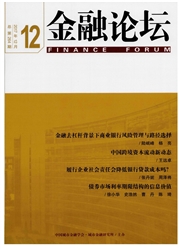

 中文摘要:
中文摘要:
新券效应与国债品种特征、投资者行为和市场微观结构均有密切关系。上交所和银行间国债市场的新券效应不仅存在共同点,也存在明显差异。在交易额占比最大的基准国债品种上,两个市场均表现出显著的新券效应。但由于投资者行为存在差异,上交所国债市场的新券效应更倾向于中长期国债品种,而银行间国债市场的新券效应更倾向于短期国债品种。而且,上交所国债市场的指令驱动交易方式便于连续交易和信息披露,方便考察新券效应,而银行间国债市场仅能在较短时间内考察新券效应。在上交所国债市场上,中长期国债与国债回购的利差更大,有利于现券回购套利投资,中长期新券吸引套利投资者积极参与,也促进了新券效应。
 英文摘要:
英文摘要:
The effect of new honds is closely related with bond features, investors' behavior and market micro-structure. There exists similarity and dissimilarity between bond market in Shanghai stock exchange and interbank bond market as far as the effect of new bonds is concerned. With regard to benchmark treasury bonds with the largest turnover, the two markets have new bond effect. However, due to different investors' behaviors, Shanghai bond market tends to favor long and mid-term bonds while interbank mar- ket is inclined to short-term bonds. Moreover, order-driven trading method in Shanghai is suitable for continuously trading and in- formation disclosure, thus convenient for observing the effect, whereas interbank market is only suitable for short-term investigation. In Shanghai, the larger profit margin between long and mid-term bonds and buy-back encourages arbitrage by buying back current bond. Long and mid-term new bonds will attract arbitrageurs to invest, thus magnifying new bond effect.
 同期刊论文项目
同期刊论文项目
 同项目期刊论文
同项目期刊论文
 期刊信息
期刊信息
